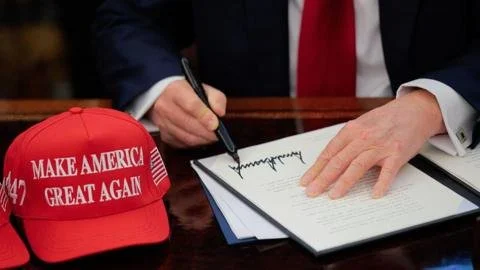Unmasking Trump's Tariff Strategy: What You Need to Know About His Trade Wars
US President Donald Trump recently announced a staggering 35% tariff on Canadian imports, effective August 1st, with new tariffs set for implementation on August 7th for numerous countries. This bold move marks a continuation of his approach to import taxes, which he claims will boost American manufacturing and protect jobs. Critics argue that his erratic trade policy has caused instability in the global economy and has led to price increases for American consumers.
Tariffs are essentially taxes imposed on imported goods. For instance, a 10% tariff on a $10 item raises the total to $11. Importers pay this tax, which they may pass on to consumers or choose to import less. A recent US trade court ruling questioned Trump’s authority to impose some tariffs, citing misuse of national emergency powers. Nonetheless, an appeals court allowed current tariffs to remain in place as legal challenges unfold.
Trump argues that these tariffs will compel US consumers to favor American-made products, enhance tax revenues, and stimulate domestic investment. He aims to reduce the US trade deficit, which he claims results from foreign exploitation. However, his approach has led to confusion, with tariffs being amended or canceled regularly, while also using them as leverage for other negotiations, such as addressing immigration and drug trafficking with Mexico and Canada.
The specific tariffs include:
50% on steel and aluminum imports
50% on copper imports starting August 1st
25% on foreign-made cars and engines
Additional threats include a 200% tariff on pharmaceuticals, and the ending of the $800 de minimis exemption for small imports, notably from China. Tariff rates against various countries vary dramatically, with Brazil facing 50%, South Africa 30%, and several others in between, indicating a broad and complex strategy.
Negotiations with China are ongoing, with both nations temporarily lowering tariffs but facing pressure to solidify trade terms. Meanwhile, other nations are experiencing significant shifts, with the UK being an exception with a relatively low 10% tariff on car exports under specific conditions, while still facing scrutiny over steel import rates.
Despite Trump’s insistence that his trade policies are beneficial, both the International Monetary Fund and the OECD have downgraded global economic growth forecasts due to these tariffs, anticipating negative impacts on the US economy as well.
As these tariffs unfold, they are already impacting US inflation rates, with prices rising on various goods. Companies like Adidas and Nike anticipate raising prices, and border customs checks have tightened, causing delays. In summary, while Trump’s tariffs aim to reshape trade dynamics favorably for America, their consequences are being felt widely, raising questions about long-term viability and economic health.

